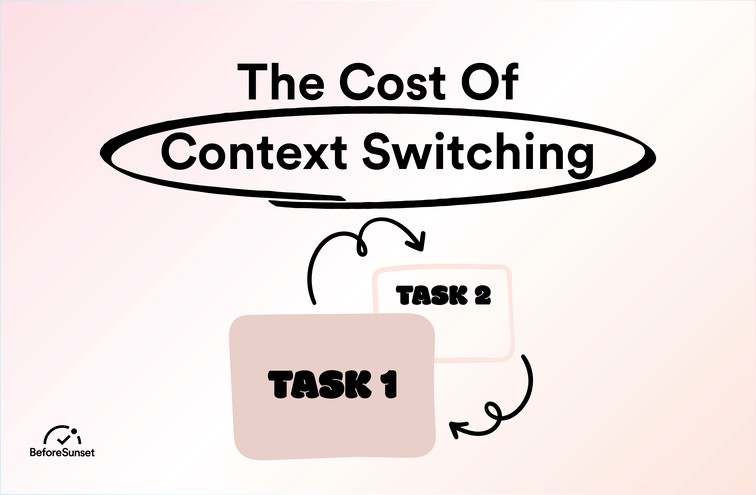In this busy work environment context switching is a must but it comes with a cost. Your productivity is your most important treasure, it is what keeps you going. When you are constantly context switching your productivity gets lower and lower.
But what does context switching mean? We are here to find that out.
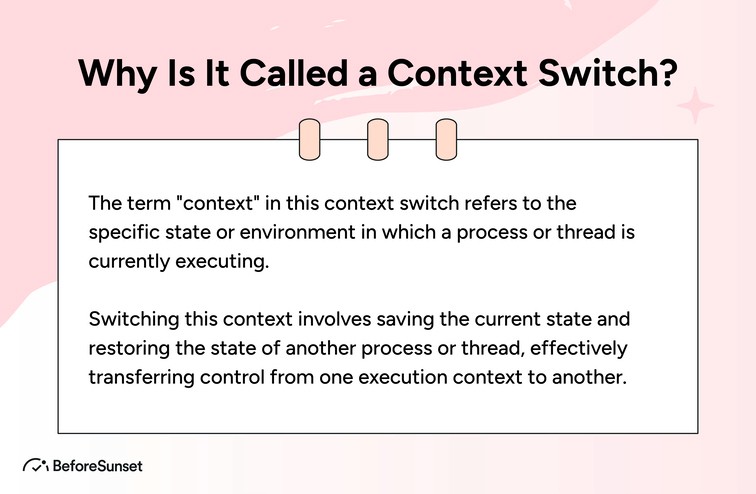
Why Is It Called a Context Switch?
In computer science and operating systems, "context switch" refers to the process of changing the execution context from one task or process to another. The idea of retaining a task's execution context or environment is where the term "context switch" originates.
The current values of CPU registers, the program counter, the stack pointer, and other pertinent data are just a few examples of the components that make up a task's execution context. This context captures the task's current state, together with the details required for the job to restart execution without interruption.
The present execution context is saved or kept during a context transition, and the context for the upcoming job is loaded or restored. By using this switch, the operating system may switch between many activities with ease, giving the impression that they are all running at once.
The environment or status related to a particular work is referred to as the "context" in the phrase "context switch". It reflects the total set of information and assets required for the task to be completed successfully and go forward. The system creates the appearance of concurrent execution by altering the execution context, which effectively transfers control from one task's context to another.
The term's switch component refers to the process of switching between several execution contexts. It entails preserving the current task's state, updating pertinent data structures, loading the state of the following task, and smoothly continuing execution.
Overall, the term "context switch" underscores the essential idea of switching between several contexts for task execution while keeping and regaining the information required to guarantee task execution continuity in a multitasking environment.
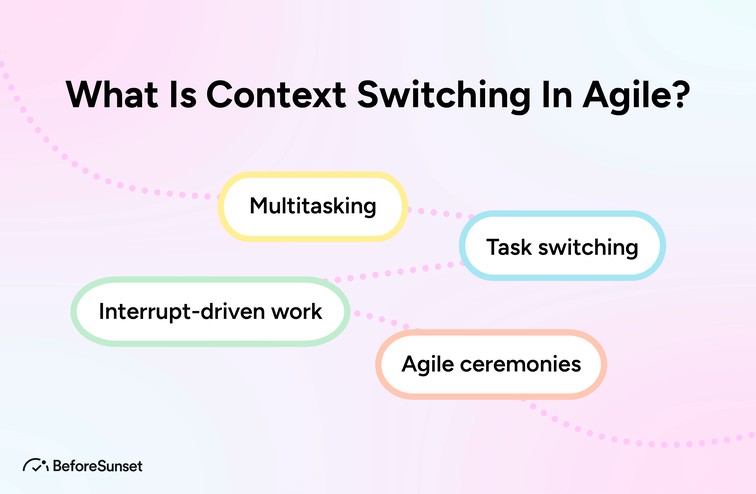
What Is Context Switching In Agile?
The technique of moving a development team's attention from one work or project to another is known as "context switching" in the context of Agile software development. It happens when team members are asked to work on many tasks at once or often flip between various projects or priorities.
Here are a few Agile context switching considerations:
Task switching: Agile teams frequently tackle tiny work units known as user stories or tasks in an iterative and progressive way. When team members transition from working on one job to another owing to a change in priorities, new requirements, or the need to handle urgent concerns, this is known as context switching.
Multitasking: Agile teams frequently work across functional lines and jointly develop different project components. Context switching happens when team members must balance several tasks at once, such as attending meetings, responding to support tickets, or working on several separate features at once.
Agile ceremonies: Scrum and other agile approaches entail regular stand-up meetings, sprint planning sessions, and retrospectives. When team members shift their attention away from their development work to attend these meetings or take part in other Agile-related activities, context switching may occur.
Interrupt-driven work: Agile teams frequently have to react to unforeseen occurrences, such as urgent production problems, client requests, or important bug patches. Context switching happens when developers must stop working on other projects to handle these unforeseen chores, taking their focus away from the main development initiatives.
Agile context change can have both beneficial and detrimental effects:
Advantages:
Flexibility: Agile teams may swiftly shift their attention to take care of new tasks or emergent demands in order to respond to changing requirements and priorities.
Collaboration: By allowing team members to work on various project components, context switching promotes knowledge exchange and cross-functional cooperation.
Response time: Agile teams may quickly respond to pressing demands or client feedback by reorganizing work and shifting their priorities as necessary.
Disadvantages:
Reduced productivity: Constantly changing contexts might result in a loss of efficiency and productivity. When transitioning between jobs, it takes time for team members to reestablish their mental context and attention.
Increased cognitive load: Constantly switching between jobs or projects can lead to an increase in cognitive load, which can affect one's ability to concentrate, make decisions, and produce work of a high standard.
Bottlenecks and delays: As team members split their focus across several projects, excessive context switching can cause delays and bottlenecks in project execution.
Agile teams can adopt tactics including minimizing work in progress, setting clear goals, enhancing communication and collaboration, and allocating specific time for concentrated work to lessen the consequences of context shift.
What is a Context Switching Example?
Context switching can change from person to person, If you are a student your context switching can look different than a professional.
A student might be studying Math but had an English question stuck in their mind when they switch contexts their brain spends time an energy to focus on the new context which lowers productivity. To avoid it you must finish one task before starting a new one.
For a professional, this can look like switching from one project to the next one or replying to an urgent email while working on a task. Your focus will be much lower and your tendency to do mistakes is higher.
How Does It Impact Your Work?
When you switch context it comes in a thing called "switch cost". That cost is your performance, energy, and focus. Your pace will slow down and your tendency to make mistakes increases. We will explore it further in the problem with the context switching section.

What Are Context Switching Actions?
Context switching activities, in the context of computer systems and operating systems, refer to the actions taken by the system while changing the execution context from one task or process to another. Usually, these steps entail preserving the current task's state and restoring the state of the following task. The typical context-switching acts are listed below:
Saving the current context: Whenever a context transition is made, the system must store the details of the job that is now running, such as its stack pointer, program counter, and CPU register values. This makes it possible to continue the current job later exactly where it left off.
Updating task data structures: Task data structures are updated by the operating system, which also changes task control blocks and other pertinent data structures related to the current task. These data structures provide information about resource allocations, scheduling, and the task's execution status.
Scheduling: The operating system decides which task should be done next after saving the context of the current task. Usually, scheduling algorithms, priorities, and other considerations are used to make this choice. The next job is chosen by the scheduler from the list of tasks that are available for execution or the ready queue.
Adding the following context: The system loads the chosen task's stored state after choosing the next job to execute. In order to prepare for the following work, it is necessary to restore the values of the CPU registers, program counter, stack pointer, and other pertinent data.
Restoring task data structures: Data structures relevant to the next task, such as process control blocks or task control blocks, are updated by the operating system to indicate that the task is now executing or being executed.
Resuming execution: The system passes control to the restored program counter after the context of the following task has fully loaded, enabling the subsequent task to pick up where it left off with its prior execution. The following task's instructions are put into action by the CPU.
These operating system low-level context switching operations are normally controlled by the kernel. Context switching often might affect system performance since it adds overhead from having to preserve and restore task states. To reduce this cost and guarantee the best possible use of system resources, effective context switching techniques and methods are used.
The Problem With Context Switching
Context switching is one of the hardest things for us to do. It sounds easy, but it's not. It makes us feel out of control. I'll tell you why context switching is problematic so that you will be one step closer to being more productive at work.
1. Decreased productivity
When you are constantly switching contexts your productivity decreases. Let's analyze why that happens. You were working on a task and your coworker asked you to look into another project immediately. Your brain took the effort to refocus on the new task you have in hand but it takes time and energy. Therefore you are now stressed and your focus is much lower.
When all the problems come together your productivity decreases. If you were to finish the task you had in hand, took a break, and started a new one you would be more productive.
2. Increased stress and anxiety
When you are context switching your brain constantly needs to adjust and reorient itself. This can be mentally taxing which results in feelings of frustration, confusion, and a lack of focus. The constant interruptions can make it difficult to fully immerse oneself in a task. As a result of this, you will feel dissatisfaction and a lack of accomplishment.
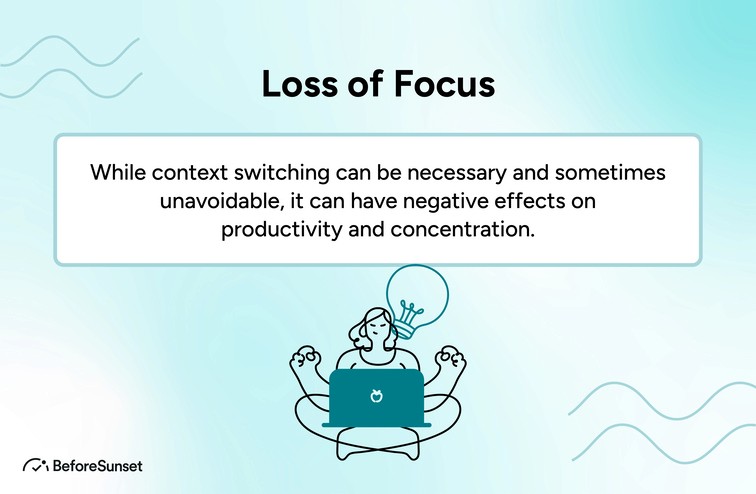
3. Loss of focus
What causes loss of focus is mental fatigue caused by context switching. It makes it difficult to maintain concentration on any one thing for an extended period of time. Constant interruptions can disrupt the flow of thought, making it harder to get back to the task at hand.
What your brain needs is to expend extra energy to recall the details of the previous task and reorient itself to the new task. Give your brain the time it needs.
4. Reduced overall efficiency
Context switching can be incredibly disruptive because it takes time for your brain to refocus on a new task and remember what you were doing before. And when that happens over and over again throughout the course of one day or even just one hour, it can really affect your efficiency in ways that are hard for even experts to quantify.
5. Increased risk of error
When you lose focus because of context switching the risk of making errors increases. If you are thinking why that happens it is because the constant interruptions can disrupt the flow of thought, making it harder to recall important information or details about a task.
Also, context switching can make it difficult to fully immerse oneself in a task, which leads to a lack of attention to detail, thus increasing the risk of error.
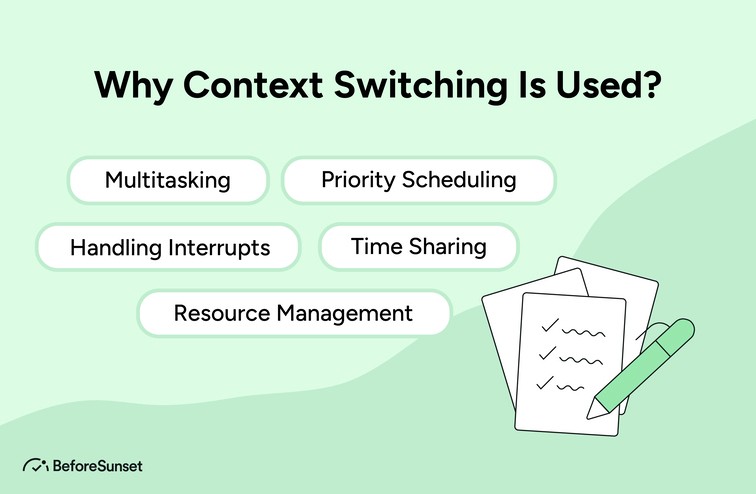
Why Context Switching Is Used?
Computer systems and multitasking operating systems employ the method of context switching to manage numerous activities or processes. It entails the act of saving and recovering a process's or thread's state so that it can be continued at a later time. The system may effectively move between several tasks thanks to context switching, creating the appearance of concurrent execution.
The following are possible justifications for context switching:
Multitasking: Context switching makes it possible for operating systems to multitask, which is the process of running several processes at once. The operating system may create the appearance of running numerous applications simultaneously even if the CPU can only handle one operation at a time by switching between them quickly.
Resource management: Context switching enables more effective use of system resources, including the CPU. The operating system has the ability to swiftly transition to another job that is prepared to run while one process is stalled or waiting for input/output procedures. In this manner, the CPU is not idle and the system can advance via the completion of other tasks.
Time sharing: Context switching makes time sharing in multi-user systems easier. Multiple users can share system resources like the CPU and memory in a time-sharing scenario. In order to ensure fairness and responsiveness, context switching enables the operating system to divide the CPU time across all users or tasks into discrete time chunks.
Priority scheduling: Context switching is necessary for the implementation of priority-based scheduling algorithms. In comparison to lower priority activities, higher priority jobs require greater CPU time. The operating system can regularly reevaluate the priority levels and modify the scheduling by executing context switches.
Handling interrupts: When an interrupt, such as one caused by hardware or software, occurs, the system must switch to the interrupt handler in order to respond to the event. Context switching enables a seamless transfer from the interrupted process to the interrupt handler, ensuring prompt and effective interrupt handling.
It's crucial to remember that context switching has overhead. It takes time and uses up system resources to save and restore a process or thread's state. As a result, reducing pointless context shifts is crucial for improving system efficiency.
Ways to Reduce the Cost of Context Switching
It's a fact that people hate it when you change the context in which they are working. We feel discomfort and irritation when we switch between different tasks. In fact, there is an entire discipline called "Interruption Science" just dedicated to studying the negative consequences of switching from one task to another. And from this perspective, we can conclude that reducing the cost of context switching is critical to succeeding in any project or task.
Minimize the number of distractions
Have you ever felt like you've been working on the same project for hours, and then suddenly realized that you've spent the entire time switching between five different tasks? It's so easy to get caught up in new ideas or to get distracted by a text from a friend, or even just to feel like you need a break from what you're doing.
That is why you must eliminate distractions and focus on the task you have at hand.
Use technology to prioritize tasks
When you prioritize tasks and look at them one task at a time you will eliminate context switching that will result in a more productive work day. You can get the help of technology when doing that. You can use to-do lists and calendar apps to prioritize the tasks at hand.
What is even better is that while using the technology you can use different m methods such as time timeboxing.
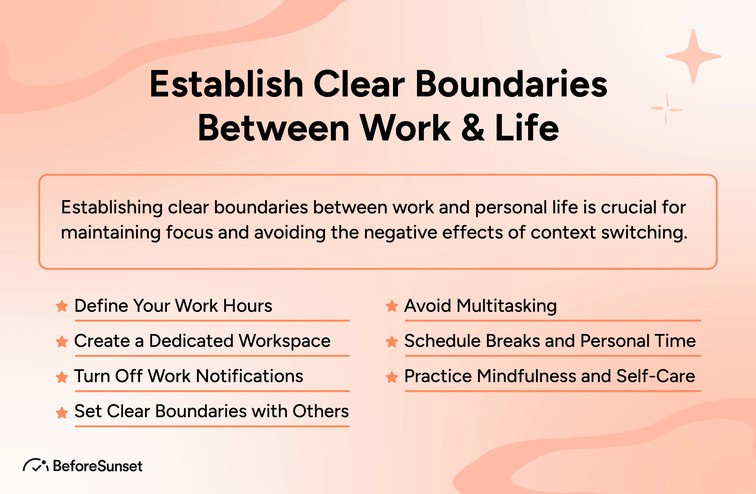
Establish clear boundaries between work and life
What makes you switch context doesn't always have to be another work or school related project. Your private life such as text from friends or social media notifications can also distract you from your work. What you need to do is to establish clear boundaries between work and life. You must create a work-life balance that will not only benefit in terms of context switching but pşroductivity as well.
Delegate tasks to others when possible
Task delegation is a good way to manage your time and workload because it lets you focus on the most important tasks while others take care of less important or routine tasks. This way your need for context switching will be much lower.
Evaluate your process of context switches
To evaluate your context switching process, you need to look at how often and when you switch between tasks, as well as how these changes affect your productivity and effectiveness. To figure out how well you switch between tasks, you can keep track of how often you do it and how long you spend on each task before switching. You can also write down why you switch tasks, like being interrupted, being distracted, or not being able to concentrate.
Once you have this information, you can look for patterns and habits like multitasking, putting things off, or not being good at managing time that may be causing you to switch between tasks too often. Then, you can come up with ways to avoid switching contexts too often, like using tools to track time, setting clear goals for each task, and making a schedule to limit interruptions.
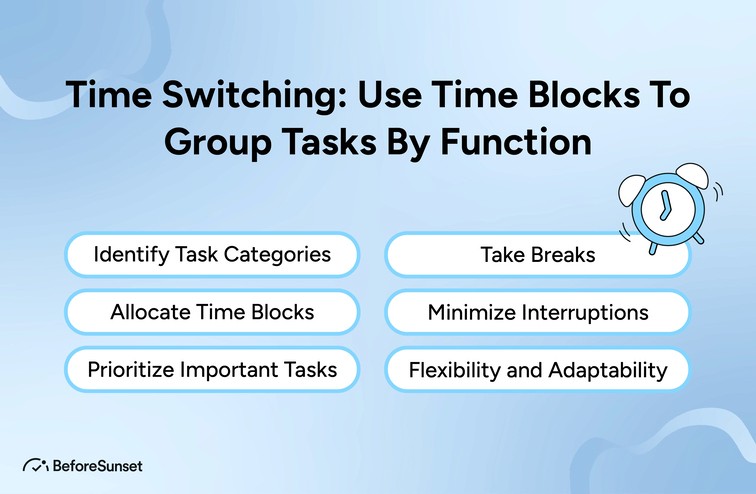
Time switching: Use time blocks to group tasks by function
Time blocking is another great way to avoid context switching. This technique involves scheduling specific blocks of time throughout the day to focus on different types of tasks, such as email, phone calls, administrative tasks, and project work.
This method also lets you plan for any possible interruptions so you don't have to stop working when they happen.
Try the Pomodoro technique
Pomodoro technique is used by many to be more productive at 25 minute intervals.
Here's how it works:
Decide on the task to be done.
Set a timer for 25 minutes (the Pomodoro) and work on the task until the timer rings.
Take a short break (5 minutes)
Every four "Pomodoros" take a longer break (15-30 minutes)
Are you interested in Pomodoro? Well, you are lucky because we have the best Pomodoro timer that will make your productivity dreams come true.
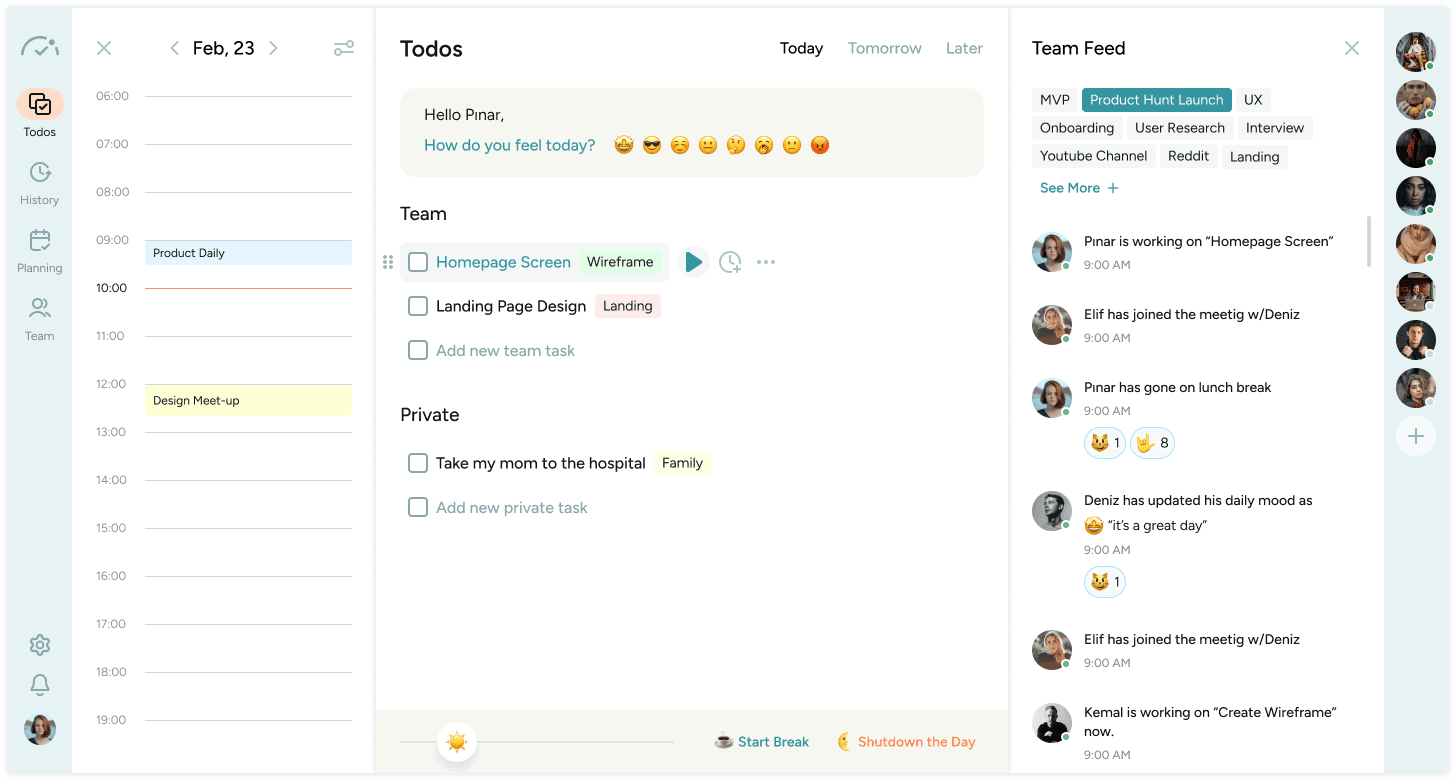
Invest in productivity tools
Do you want to limit your context switching? One of the best ways to do so is to be mindful of how you are spending your time.
Keeping track of your time can help you switch between tasks by giving you a clear picture of how you spend your time during the day. By keeping track of how much time you spend on different tasks and activities, you can find patterns and habits that might be causing you to switch between tasks and activities too often. This can include doing too many things at once, putting things off, or not being good at managing time.
And the best way to track your time is by using BeforeSunset!
